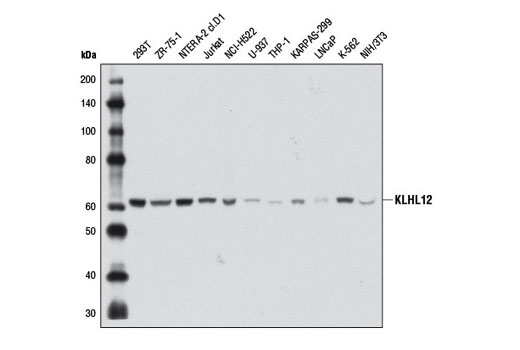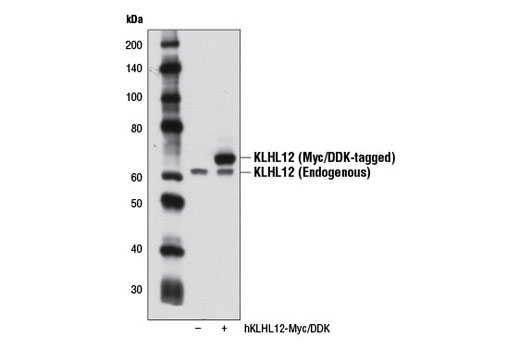WB
H M Mk
Endogenous
62
Mouse IgG1
#Q53G59
59349
Product Information
Product Usage Information
| Application | Dilution |
|---|---|
| Western Blotting | 1:1000 |
Storage
Specificity / Sensitivity
Species Reactivity:
Human, Mouse, Monkey
Source / Purification
Monoclonal antibody is produced by immunizing animals with a recombinant protein specific to the carboxy terminus of human KLHL12 protein.
Background
Cullins are proteins that function as molecular scaffolds for modular ubiquitin ligases typified by the SCF (Skp1-CUL1-F-box) complex (1-3). The substrate selectivity of these E3 ligases is dictated by a specificity module that binds cullins. In the SCF complex, this module is composed of Skp1, which binds directly to CUL1, and a member of the F-box family of proteins such as Skp2 (1-4). CUL3 has been shown to be required for embryonic development in mammals and Caenorhabditis elegans (5-7) but until recently, its substrate specificity adaptor had yet to be elucidated. It is now recognized that substrate adaptors for CUL3-based ubiquitin ligase complexes contain a conserved BTB/POZ (Pox virus and Zinc finger) domain. This domain, which was initially identified in the Drosophila transcriptional repressors broad complex, tramtrack, and bric-a-brac is present in more than 190 human proteins. BTB proteins contain a variety of putative protein-protein interaction domains, including MATH domains, zinc finger repeats, and kelch repeats (8).
There are several lines of evidence suggesting that Kelch-like 12 protein (KLHL12) is a substrate-specific adaptor for the CUL3-based ubiquitin ligase complex. Analysis of the amino acid sequence of KLHL12 reveals an amino-terminal BTB motif, a central linker region, and a carboxy-terminal kelch domain composed of kelch repeats. Furthermore, KLHL12 has been shown to negatively regulate Wnt signaling by binding Disheveled and targeting it for ubiquitin-dependent proteasomal degradation (9). More recently, KLHL12 was shown to drive the assembly of large COPII vesicles by promoting the monoubiquitination of the COPII component Sec31. As a result, CUL3-KLHL12-dependent ubiquitination is essential for collagen export, a step that is required for integrin-dependent mouse embryonic stem cell division (10).
- Zheng, N. et al. (2002) Nature 416, 703-9.
- Skowyra, D. et al. (1997) Cell 91, 209-19.
- Feldman, R.M. et al. (1997) Cell 91, 221-30.
- Bai, C. et al. (1996) Cell 86, 263-74.
- Singer, J.D. et al. (1999) Genes Dev 13, 2375-87.
- Winston, J.T. et al. (1999) Genes Dev 13, 2751-7.
- Kurz, T. et al. (2002) Science 295, 1294-8.
- Collins, T. et al. (2001) Mol Cell Biol 21, 3609-15.
- Angers, S. et al. (2006) Nat Cell Biol 8, 348-57.
- Jin, L. et al. (2012) Nature 482, 495-500.
Species Reactivity
Species reactivity is determined by testing in at least one approved application (e.g., western blot).
Western Blot Buffer
IMPORTANT: For western blots, incubate membrane with diluted primary antibody in 5% w/v nonfat dry milk, 1X TBS, 0.1% Tween® 20 at 4°C with gentle shaking, overnight.
Applications Key
WB: Western Blotting
Cross-Reactivity Key
H: human M: mouse R: rat Hm: hamster Mk: monkey Vir: virus Mi: mink C: chicken Dm: D. melanogaster X: Xenopus Z: zebrafish B: bovine Dg: dog Pg: pig Sc: S. cerevisiae Ce: C. elegans Hr: horse GP: Guinea Pig Rab: rabbit All: all species expected
Trademarks and Patents
使用に関する制限
法的な権限を与えられたCSTの担当者が署名した書面によって別途明示的に合意された場合を除き、 CST、その関連会社または代理店が提供する製品には以下の条件が適用されます。お客様が定める条件でここに定められた条件に含まれるものを超えるもの、 または、ここに定められた条件と異なるものは、法的な権限を与えられたCSTの担当者が別途書面にて受諾した場合を除き、拒絶され、 いかなる効力も効果も有しません。
研究専用 (For Research Use Only) またはこれに類似する表示がされた製品は、 いかなる目的についても FDA または外国もしくは国内のその他の規制機関により承認、認可または許可を受けていません。 お客様は製品を診断もしくは治療目的で使用してはならず、また、製品に表示された内容に違反する方法で使用してはなりません。 CST が販売または使用許諾する製品は、エンドユーザーであるお客様に対し、使途を研究および開発のみに限定して提供されるものです。 診断、予防もしくは治療目的で製品を使用することまたは製品を再販売 (単独であるか他の製品等の一部であるかを問いません) もしくはその他の商業的利用の目的で購入することについては、CST から別途許諾を得る必要があります。 お客様は以下の事項を遵守しなければなりません。(a) CST の製品 (単独であるか他の資材と一緒であるかを問いません) を販売、使用許諾、貸与、寄付もしくはその他の態様で第三者に譲渡したり使用させたりしてはなりません。また、商用の製品を製造するために CST の製品を使用してはなりません。(b) 複製、改変、リバースエンジニアリング、逆コンパイル、 分解または他の方法により製品の構造または技術を解明しようとしてはなりません。また、 CST の製品またはサービスと競合する製品またはサービスを開発する目的で CST の製品を使用してはなりません。(c) CST の製品の商標、商号、ロゴ、特許または著作権に関する通知または表示を除去したり改変したりしてはなりません。(d) CST の製品をCST 製品販売条件(CST’s Product Terms of Sale) および該当する書面のみに従って使用しなければなりません。(e) CST の製品に関連してお客様が使用する第三者の製品またはサービスに関する使用許諾条件、 サービス提供条件またはこれに類する合意事項を遵守しなければなりません。

